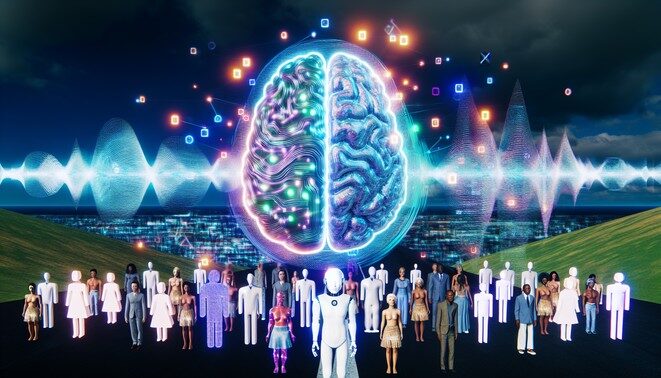Introduction to Voice Synthesis
Voice synthesis technology has come to play a crucial role in today’s digital landscape, significantly influencing various applications in communication, entertainment, and accessibility. At its core, voice synthesis involves the use of AI algorithms and machine learning models to generate human-like speech from text input. This technology has made substantial strides due to advancements in neural networks and deep learning, enabling more natural and expressive speech patterns that closely resemble human voice inflections and emotions [Source: PV Magazine].
One of the primary drivers behind these advancements is the increasing demand for personalized and interactive user experiences. Applications of voice synthesis range from virtual assistants like Amazon’s Alexa and Apple’s Siri to tools that aid those with speech disabilities, creating opportunities for better communication and interaction [Source: Farmonaut]. Furthermore, the technology is widely used in industries such as gaming, teleconferencing, and e-learning, enhancing user engagement and accessibility [Source: Nature].
Despite the promise of voice synthesis, the technology also faces several challenges, including ethical considerations surrounding voice imitation and the potential for misuse [Source: Nature]. As the field continues to evolve, addressing these concerns will be crucial for ensuring responsible development and deployment of voice synthesis systems.
Understanding the Mechanisms of Voice Synthesis
Voice synthesis technology utilizes advanced algorithms, machine learning models, and neural networks to produce lifelike voice outputs. At its core, voice synthesis relies heavily on two primary methods: concatenative synthesis and parametric synthesis. Concatenative synthesis involves piecing together segments of recorded speech, while parametric synthesis generates speech using mathematical models that simulate vocal characteristics.
Neural networks, particularly deep learning models, have revolutionized voice synthesis by providing mechanisms that can learn from vast amounts of data to effectively mimic human speech patterns. These models, such as WaveNet, employ deep generative techniques to produce audio waveforms at a sample level, significantly improving the naturalness of synthesized speech compared to traditional methods [Source: PV Magazine].
Text-to-speech systems, a common application of voice synthesis, use natural language processing alongside these neural network models to convert written text into spoken words. This process consists of analyzing the text for phonetic content and then generating corresponding speech patterns, resulting in an intelligible and expressive vocal output [Source: Farmonaut].
Implementations of voice synthesis today include virtual assistants, automated customer service agents, and language translation applications, all of which leverage these complex algorithms and models for enhanced user interaction and communication. The integration of advanced machine learning techniques has ultimately pushed voice synthesis towards delivering more engaging and human-like auditory experiences.
Applications of Voice Synthesis in Various Industries
Voice synthesis technology is revolutionizing various industries, enhancing user experience and streamlining operations. Here’s how it’s making an impact across gaming, customer support, education, and entertainment.
Gaming
In the gaming industry, voice synthesis creates more immersive experiences for players. Developers utilize AI-generated voices for non-playable characters (NPCs) to deliver dynamic dialogue, allowing for an engaging storytelling experience. This technology facilitates on-the-fly voice generation, enabling games to respond to player actions in real time. Games like *Cyberpunk 2077* have experimented with this technology, where synthesized voices contribute to the liveliness of the game world [Source: IGN].
Customer Support
Many organizations have adopted voice synthesis in customer service applications to improve efficiency and user satisfaction. AI-driven chatbots equipped with voice synthesis capabilities can manage inquiries without human intervention, handling repetitive tasks while providing a natural-sounding interaction. Companies such as Google and Amazon have integrated this technology into their customer support systems, significantly reducing response times and operational costs [Source: Forbes].
Education
Voice synthesis is making learning more accessible, especially for those with visual impairments or learning disabilities. Educational platforms use AI-generated voices to read out content, making lessons adaptable to various learning styles. Students can engage with materials in modern language arts or foreign language classes via audio instead of traditional reading [Source: EdTech Magazine]. This inclusion fosters an interactive learning environment, personalizing the educational experience.
Entertainment
In the realm of entertainment, voice synthesis technology is leveraged for creating character voices in animated films and series. This innovation allows studios to produce films at a lower cost by reducing the need for extensive voice actor bookings. For example, Disney has experimented with AI voices in animated features, allowing for quicker edits and adaptations during production [Source: Thrillist]. Moreover, this technology can resurrect voices of past artists for new productions, albeit not without ethical considerations.
In summary, voice synthesis is reshaping industries by enhancing user interaction, optimizing processes, and expanding accessibility, setting a strong foundation for future advancements in how we communicate and engage with technology.
Best Practices for Implementing Voice Synthesis
Integrating voice synthesis into your projects demands careful planning and execution to enhance user experience and maintain ethical standards. Here are some best practices to consider:
1. **Emphasize User Feedback**: Gathering user feedback is critical to refining voice synthesis applications. Implement methods like beta testing or usability studies, where users can provide insights on voice quality, clarity, and emotional tone. Responding to this feedback can significantly improve user satisfaction and engagement. Research indicates that user-centered design approaches lead to more effective voice interactions, enhancing overall performance and acceptance [Source: Nature].
2. **Strategic Voice Selection**: The choice of voice in synthesis systems affects user perception and interaction. Select voices that match the tone and context of your application, whether it be professional, friendly, or authoritative. Consider offering users a choice in voice selection, enabling a personalized experience that can increase user comfort and trust in the system. Avoid using synthetic voices that may sound robotic or unnatural, as they can deter users [Source: PV Magazine].
3. **Address Ethical Considerations**: The deployment of voice synthesis technology brings ethical challenges, such as issues of consent, privacy, and representation. Ensure transparency in how voice data is collected and used, obtaining user consent before recording. Additionally, be mindful of biases that may be present in voice data, aiming for diversity to avoid perpetuating stereotypes or exclusion in representation. Establishing ethical guidelines can help mitigate potential misuse and foster responsible innovation in voice technology [Source: Farmonaut].
By following these best practices, you can enhance the effectiveness of voice synthesis in your projects while addressing user needs and ethical responsibilities head-on.
Future Trends in Voice Synthesis and AI
The future of voice synthesis and AI is poised for significant advancements, driven by trends in personalized voice synthesis and multilingual capabilities. As technology progresses, the demand for more human-like, individualized voice interactions is increasing. One major trend is the development of personalized voice synthesis, where AI can create distinct voices that mimic individual tones and speech patterns, enhancing user engagement across various platforms, including virtual assistants and gaming. This trend not only enhances user experience but also opens avenues for creating unique brand identities through voice.
Multilingual capabilities are also set to expand significantly. Emerging systems are being developed that can seamlessly switch between multiple languages within a single conversation. This advancement is particularly relevant in diverse environments, such as customer service, where companies engage with clients worldwide, as it enhances accessibility and inclusivity. Companies like Google and Microsoft are investing heavily in natural language processing to improve these systems, enabling more effective communication across linguistic barriers.
However, these advancements come with challenges. Ethical considerations around data privacy and voice cloning are becoming increasingly significant. As the technology evolves, concerns regarding unauthorized voice replication and its implications are growing, highlighting the need for robust regulatory frameworks. Additionally, ensuring AI understands cultural nuances and context in language will be crucial in achieving true multilingual proficiency. The balance between innovation and ethical responsibility will shape the discourse around these technologies in the coming years.
For more information on AI applications in various industries, check out our related articles on AI Innovations and Voice Technology Trends.
Sources
- EdTech Magazine – Voice synthesis assists students’ learning needs
- Forbes – How AI Voice Synthesis is Changing the Customer Service Industry
- Thrillist – Disney AI Voice Actor Assistant
- IGN – Cyberpunk 2077 Uses AI-Generated Voices to Enhance Gaming Experience
- PV Magazine – Open Source Tools to Build Self-Made Management System for Surplus PV Power
- Farmonaut – Cloud Computing for Agriculture: 5 Smart Cloud Farming Uses
- Nature – [Article Title Not Provided]




